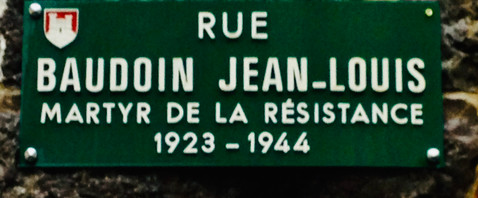Résister
- JanetJoanouWeiner

- Jan 24, 2021
- 3 min read
The tradition of resistance runs deep in the Cévennes and in our little town of St. Hippolyte du Fort. We're situated at the southern end of the Cévennes National Park, about an hour away from the Vallée Française, which has a rich history of resisting tyranny and injustice. In fact, the original name was Val Francesque, meaning "valley of the free."

Our region is known as a bastion of Protestants (Huguenots), from the 16th century to today. The inspiring story of their resistance to the powerful King Louis XIV demonstrates attempted loyalty to their sovereign and their beliefs. I wrote a bit about this in the post: Why St. Hippolyte du Fort? from last September.
But the thread of resistance runs through this region far beyond that of the Huguenots. Sometime during the 10th century, Roland, of Chanson de Roland fame and possibly the nephew of King Charlemagne, stopped the Saracens' advance on a ridge in the Vallée Française. A black granite chapel was built to commemorate the victory. It has since become a Protestant temple. Centuries later, the French stopped English troops here, at their furthest point of advancement in the 100 Years War.

Along with resistance to invading forces, the Cévennes also has a long history of providing refuge. During the French Revolution at the end of the 18th century, priests were sheltered here from persecution, as were deserters during the Napoleonic Wars. In the mid-19th century, the region became a hideout for opponents of Napoleon's successor, Louis.
My favorite act of resistance and refuge came again in the Vallée Française. For over a century, on the first Sunday of September, thousands of Protestants gather there in memory of the underground church under Louis XIV's repression and beyond. This Assemblée du Désert served in 1940 as cover to bring over 100 Jews into the Cévennes. They were concealed here, absorbed into locals' homes, for the rest of the War. Emotion rises; I am honored to live among such people. Should I ever have the opportunity, I pray I would respond with their courage and self-sacrifice.

Assemblée du Désert, first Sunday of September
A prominent historian of this area recently wrote a book on the sheltering of Jews during World War 2. The title: Nous devions le faire. Nous l'avons fait…We needed to do it. We did it. The subtitle–Cévennes, the history of a land of refuge 1940-1944–sums up well the spirit of this place.

Tour Constance
Résister. Resist. Scratched into stone by a young Huguenot woman, Marie Durand, famously imprisoned in the Tour de Constance (in Aigues-Mortes to the south of us). Arrested at age nineteen simply for belonging to a Protestant family and attending a church service. Asked each day by her captors to renounce her faith and be set free, she refused and remained incarcerated for 38 years.

Marie Durand in the Tour Constance by Jeanne Lombard
Her life and legacy of Résister was the source of inspiration for a young Parisian woman in the early stages of World War 2. Protestant Yvonne Oddon was part of the fledgling underground anti-Nazi movement. She helped produce their first pamphlet in 1940, giving it the title: Résistez. The renowned French Resistance movement was born. Yvonne was arrested soon after by the Gestapo and spent the rest of the War incarcerated in a German fort. Like Marie Durand, she survived her long ordeal and eventually returned home.

I am grateful to live in such a land, surrounded by such stories. And there are so many more. Many streets in my little town of St. Hippolyte du Fort bear the names of "martyrs of the Résistance." Up the road from my home is a monument to several maquisards (local Resistance fighters) killed in a skirmish there with SS troops. Their names and memories will not be forgotten.
Nor should we forget the terrible cost of standing up to tyranny, to paying a high price for what is right. Many have done so with their lives throughout the centuries. May we honor their sacrifice, and the gift of life, by remaining firm in what is true and just, no matter the consequences.
La vie est belle.

















Oh, Janet, you know I have loved everything you have written--but you KNOW this was my favorite. Thank you for sharing. Question: Does that first Sunday of September happen every year? If so, I might one day have to make sure to head out to France then!